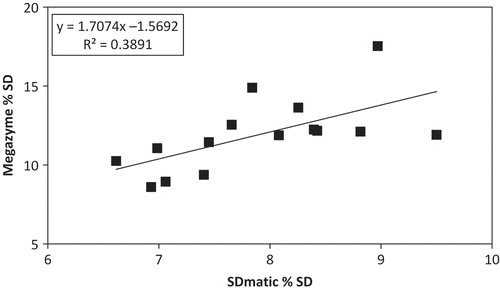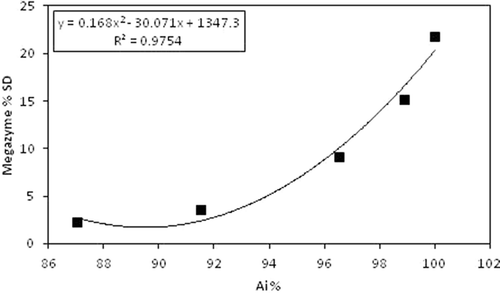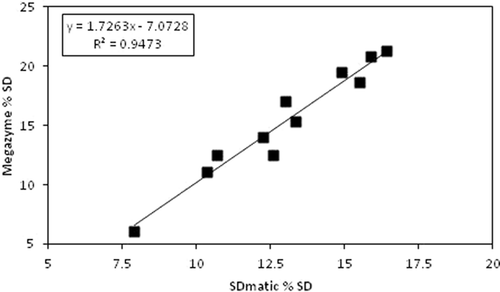Abstract
As a major component of cereal grains, including sorghum, starch plays an important role not only in grain development but also in post-harvest processing and end-product quality. Since milling can lead to the inadvertent disruption of starch granules, negatively affecting dough rheology, monitoring of starch damage is an important part of flour formulation. As the existing methods for quantifying starch damage are time-consuming, an alternative non-enzymatic methodology was sought. This study described the use of SDmatic—an instrument developed for determining starch damage in wheat flour—for assessment of sorghum flour via generation of a standard calibration. The known starch damage values were integrated to the SDmatic Ai%, and the starch damage was calculated using the following equation: Starch Damage = aAi%2 + bAi% + c. The following variables were developed for calibrating sorghum starch damage: a = 0.168, b = −30.123, and c = 1349.648. Using this calibration developed specifically for sorghum flour increased our linear regression from initial R2 = 0.38 to R2 = 0.95.
Introduction
Starch is the most abundant component (65–75%) of a majority of commercially important cereals. It is localized in the grain endosperm and stored as bimodally sized, water-insoluble granules.[Citation1] During the course of dry-milling, these granules may be disrupted, potentially allowing water and endogenous starch-degrading enzymes to prematurely access the starch within. Starch is an essential commodity in the production of baked goods, and a certain (product-dependent) percentage of damaged starch is necessary for optimal dough matrix formation. However, the presence of a large amount of damaged starch can negatively affect dough rheology, leaving it sticky and prone to collapse.[Citation2] As damaged starch excessively swells in cold water and increases water absorption by flour,[Citation3,Citation4] the resultant baked products have a heavy texture with poor consumer acceptance.
The current methods used to measure starch damage have been targeted for use in wheat flour formulations, and include the Megazyme Kit (Megazyme International, Wicklow, Ireland) and the SDmatic instrument (Chopin Technologies, Cedex, France). The SDmatic measures starch damage amperometrically via iodine absorption; the greater the starch damage, the greater is the iodine absorption. This methodology was initially developed and calibrated to measure starch damage in dry milled wheat flour. Another widely utilized methodology is AACCI Method 76-31, using the Megazyme starch damage assay kit. In this method, damaged starch granules are enzymatically hydrolyzed to glucose, and their concentration is measured with glucose oxidase/peroxidase reagent to yield a colorimetric result. The Megazyme assay is time-consuming and labor intensive; however, it yields accurate and reproducible results.
Sorghum is gaining popularity in the U.S. food industry. Patients with celiac disease, in particular, are interested in gluten-free cereal grains that can be used as an alternative to wheat.[Citation5] In addition, sorghum has a lower glycemic index than other cereal products, which may help reduce obesity as well as provide diabetics with healthier dietary options.[Citation6,Citation7] Consequently, as part of the sorghum food product development process, characterizing the amount of starch damage due to dry milling prior to formulating gluten-free foods is of paramount importance. This study aimed to employ the rapid SDmatic method used in the wheat flour industry to determine starch damage in sorghum flour. The instrument shows promise for determining starch damage in all cereal systems more rapidly than the widely used enzymatic methodology.
Materials and Methods
White food-grade sorghum Fontanelle D-1000-7 was used to obtain preliminary data for this study. These samples were dry milled on a Buhler laboratory mill as well as a Ross roller mill to achieve 60, 80, and 100% extraction flours. The samples were also pin milled at various speeds to obtain flours of varying particle sizes with consistent composition. This dry milling regime produced flours from a single source with a wide range of starch damage. The sorghum was initially cleaned on a dockage tester (Carter-Day Company, Minneapolis, MN, USA) using the wheat cleaning configuration of the Federal Grain Inspection Service and maximum air flow for aspiration. A Perten Single Kernel Characterization System Model 4100 (Perten Instruments North America, Inc., Springfield, IL, USA) calibrated for use on sorghum was used to determine kernel hardness (AACC Method 55-31).
Calibration Equation
Several sorghum commercial hybrids (5 for calibration and 11 for validation) of varying hardness were obtained from the USDA/ARS Grain Quality and Structure Research Unit, Manhattan, KS, USA. The samples were whole ground in a Udy mill (Udy Corp., Boulder, CO, USA), and starch was isolated from all samples (including the above dry-milled samples) using the method described by Park et al.[Citation8] The moisture content of all starches was evaluated using AOAC approved method 930-15. The samples were analyzed with SDmatic (AACCI 76-33) and the Megazyme Starch Damage Assay (K-SDAM; Megazyme International, Wicklow, Ireland; AACC 76-31). The values for starch damage were then entered into the SdmLink software version 1.8 (Chopin Technologies, Cedex, France). The software then calculated a new calibration equation (starch damage = aAi%2 + bAi% + c), which was uploaded to the SDmatic instrument and used to quantify damage in the starch obtained from sorghum flour.
Statistical Analysis
A completely randomized design was used to measure starch damage in all samples of isolated sorghum starch. All analyses were performed in duplicate, and the average of the replications was presented. Linear correlation analysis was performed in Microsoft Excel version 2010.
Results and Discussion
A preliminary comparison of starch damage, as determined by the Megazyme and SDmatic assays using a wheat starch calibration, is shown in . These sorghum samples represent isolated starch and flour, dry milled, and pin milled, as previously described. The SDmatic results were consistently lower than those of the Megazyme assay, with a very poor regression between the methods. Since the existing calibration to the AACC 76-31 method is for wheat flour and not suitable for sorghum flour or meal, inaccurate results were obtained when this calibration was used for analysis of starch damage in sorghum flour. This necessitates the development of a calibration for SDmatic to facilitate the evaluation of starch damage in sorghum. Calibrations using the SDmatic for other flours currently being used in gluten free foods such as rice, corn, and quinoa are currently being evaluated. Preliminary findings indicate with the proper range of induced starch damage, calibrations may be developed for the SDmatic.
FIGURE 1 Initial linear regression comparing sorghum starch damage using SDmatic and Megazyme starch damage assays. SD = Starch Damage.

To determine the efficacy of the enzymatic method for determining starch damage, five commercial sorghum hybrid flours were dry milled on a Buhler and Ross roller mill; this method showed 2–22% of starch damage, as determined by the Megazyme assay. represents the starch damage determined by iodine absorption by the flour versus Megazyme-determined starch damage; the two data sets showed a strong second degree regression and were used to construct the SDmatic calibration curve.
The proprietary calibration software was marketed by Chopin (SDmatic) to provide a user-friendly method for determining starch damage values from known sources such as the Megazyme assay. The known starch damage values were integrated to the SDmatic Ai%, and the starch damage was calculated using the following equation: Starch Damage = aAi%2 + bAi% + c. Utilizing the values from , the following variables were developed for calibrating sorghum starch damage: a = 0.168, b = −30.123, and c = 1349.648.
To validate the model for measuring starch damage in sorghum via SDmatic, another set of 11 sorghum commercial hybrids varying in hardness, which were ground on a Udy mill, were evaluated. The starch damage in this sample set ranged 2−22%, as determined by the Megazyme assay (). When the same samples were evaluated for starch damage using the calibration equation developed for sorghum starch on Sdmatic, they generated a linear regression R2 = 0.95 (). As compared to the original regression in , the relationship between the two methods used for determining starch damage improved from R2 = 0.38 to R2 = 0.95.
Conclusions
An SDmatic calibration curve specifically for sorghum exhibited strong correlation with an enzymatic assay. Food processors now have a rapid and inexpensive alternative method of measuring starch damage in their sorghum sample without the need for time-consuming development of another calibration.
DISCLAIMER
U.S. Department of Agriculture, Agricultural Research Service, Northern Plains Area, is an equal opportunity/affirmative action employer and all agency services are available without discrimination. Mention of firm names or trade product does not constitute endorsement by the U.S. Department of Agriculture over others not mentioned.
REFERENCES
- Goesaert, H.; Brijs, K.; Veraverbeke, W.S.; Courtin, C.M.; Gebruers, K.; Delcour, J.A. Wheat Flour Constituents: How They Impact Bread Quality, and How Too Impact Their Functionality. Trends Food Science and Technology 2005, 16, 12–30.
- Dubat, A. The Importance and Impact of Starch Damage and Evolution of Measuring Methods. 2004. Retrieved from http://www.concereal.es/importance_impact_starch_damage ( accessed April 4, 2014).
- Sandstedt, R.M. The Function of Starch in the Baking of Bread. Bakers Digest 1961, 35, 36–44.
- Tara, K.A.; Finney, P.L.; Bains, G.S. Damaged Starch and Protein Contents in Relation to Water Absorption of Flours of Indian Wheats. Starch 1972, 24, 232–344.
- Kulamarva, A.J.; Sosle, V.R.; Gaghavan. Nutritional and Rheological Properties of Sorghum. International Journal of Food Properties 2009, 12(1), 55–69.
- BSTD-NRC (Board on Science and Technology for International Development-National Research Council). Lost Crops of Africa. Academic Press: Washington, DC, 1996; 127–213 pp.
- Shin, S.I.; Choi, H.J.; Chung, K.M.; Hamaker, B.R.; Park, K.H.; Moon, T.W. Slowly Digestible Starch from Debranched Waxy Sorghum Starch: Preparations and Properties. Cereal Chemistry 2004, 81, 404–408.
- Park, S.H.; Bean, S.R.; Wilson, J.D.; Schober, T.J. Rapid Isolation of Sorghum and Other Cereal Starches Using Sonication. Cereal Chemistry 2006, 83(6), 611–616.


